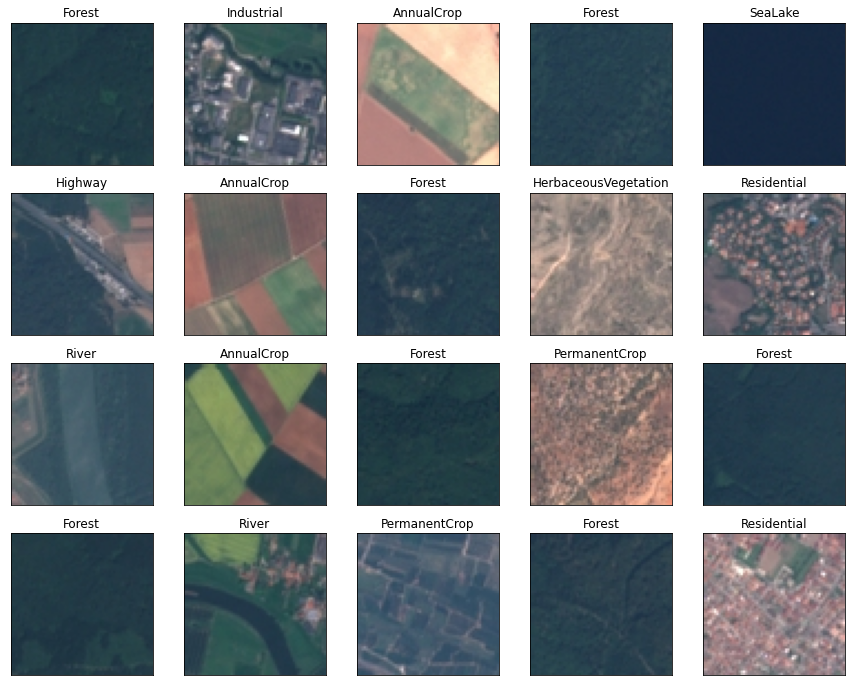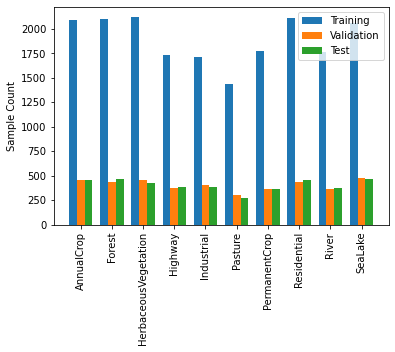Transfer Learning with Masterful¶
In this guide, you’ll go in-depth studying the usefulness of transfer learning to speed up training and deliver more accurate models. It is inspired by concepts discussed in the Keras Transfer learning & fine-tuning guide and the TensorFlow Transfer learning and fine-tuning guide. You’ll start with Imagenet pretrained weights and show how they help for a geospatial task, despite the difference in data domains.
TLDR¶
You should nearly always use pretrained weights instead of attempting to train a model from Glorot / He initialized weights.
Pretrained weights are avaiable for a variety of backbones in the
tf.keras.applicationsmodule.Using pretrained weights will both deliver a more accurate model and train faster.
The process of transfer-learning / fine-tuning the pretrained weights is automatically handled by the Masterful Python API and the Masterful CLI Trainer. See this blog post for more details.
Load the Data¶
Import TensorFlow Datasets and proceed to load Eurosat. To reduce runtime the dataset_ratio can be set below 1.0 to select only a subset of the entire dataset. The holdout_ratio variable will determine how many samples of the Eurosat dataset will be used for validation within the train loop and for a final evaluation once the optimal model has been produced. This code will split the holdout dataset in half and allocate each for the validation and test sets.
[1]:
import tensorflow as tf
import tensorflow_datasets as tfds
import masterful
masterful = masterful.register()
num_classes = 10
dataset_ratio = 1.0
holdout_ratio = 0.3
eurosat_dataset, dataset_info = tfds.load(
"eurosat", split=f"train[:{int(dataset_ratio * 100)}%]", as_supervised=True, with_info=True)
class_names = dataset_info.features['label'].names
training_dataset, holdout_dataset = masterful.utils.dataset.split_dataset(
labeled_data=eurosat_dataset, validation_ratio=holdout_ratio)
validation_dataset = holdout_dataset.shard(num_shards=2, index=0)
test_dataset = holdout_dataset.shard(num_shards=2, index=1)
print(
f"Training Samples: {masterful.utils.dataset.cardinality(training_dataset)}, "
f"Validation Samples: {masterful.utils.dataset.cardinality(validation_dataset)}, "
f"Test Samples: {masterful.utils.dataset.cardinality(test_dataset)}")
MASTERFUL: Your account has been successfully registered. Masterful v0.4.1 is loaded.
Training Samples: 18900, Validation Samples: 4050, Test Samples: 4050
Visualize the Data¶
A visual spot check ensures that the Eurosat dataset has been loaded and split correctly. It also gives us an idea of what kind of images are associated with the 10 categories that will be used to train the image classifier.
[2]:
import matplotlib.pyplot as plt
import numpy as np
row_count = 4
col_count = 5
curr_row = 0
fig, axes = plt.subplots(4, 5, figsize=(col_count * 3, row_count * 3))
for i, (x, y) in enumerate(test_dataset.take(row_count * col_count)):
axes[curr_row, i % col_count].imshow(x)
axes[curr_row, i % col_count].set_title(class_names[y])
axes[curr_row, i % col_count].set_xticks([])
axes[curr_row, i % col_count].set_yticks([])
if i % col_count == col_count - 1:
curr_row += 1
plt.show()

[3]:
training_counts = np.unique(
np.fromiter(training_dataset.map(lambda x, y: y), int), return_counts=True)[1]
validation_counts = np.unique(
np.fromiter(validation_dataset.map(lambda x, y: y), int), return_counts=True)[1]
test_counts = np.unique(
np.fromiter(test_dataset.map(lambda x, y: y), int), return_counts=True)[1]
x = np.arange(len(class_names))
bar_width = 0.25
fig, axes = plt.subplots()
training_bars = axes.bar(x - bar_width, training_counts, bar_width, label="Training")
validation_bars = axes.bar(x, validation_counts, bar_width, label="Validation")
test_bars = axes.bar(x + bar_width, test_counts, bar_width, label="Test")
axes.set_ylabel("Sample Count")
axes.set_xticks(x)
axes.set_xticklabels(class_names, rotation=90)
axes.legend()
plt.show()

Preprocess the Data¶
Training a classification model with Masterful requires the labels of each dataset to be mapped to a one-hot encoding format.
Only the training dataset ought to reshuffle after each epoch of training. If training the model exhausts all RAM that is available to the system, lower the buffer_size value for each dataset in the code cell below to circumvent this issue.
[4]:
training_dataset = training_dataset.map(
lambda x, y: (x, tf.one_hot(tf.cast(y, dtype=tf.int32), depth=num_classes, axis=-1)))
validation_dataset = validation_dataset.map(
lambda x, y: (x, tf.one_hot(tf.cast(y, dtype=tf.int32), depth=num_classes, axis=-1)))
test_dataset = test_dataset.map(
lambda x, y: (x, tf.one_hot(tf.cast(y, dtype=tf.int32), depth=num_classes, axis=-1)))
training_dataset = training_dataset.shuffle(
buffer_size=masterful.utils.dataset.cardinality(training_dataset),
reshuffle_each_iteration=True)
validation_dataset = validation_dataset.shuffle(
buffer_size=masterful.utils.dataset.cardinality(validation_dataset),
reshuffle_each_iteration=False)
test_dataset = test_dataset.shuffle(
buffer_size=masterful.utils.dataset.cardinality(test_dataset),
reshuffle_each_iteration=False)
Create the Model¶
The easiest method of loading pre-trained weights into the base model is by assigning weights="imagenet" during its instantiation. Doing so will allow the new model to leverage learned features from the much larger ImageNet dataset to perform better classification on the Eurosat dataset.
Unlike the Keras and TensorFlow transfer learning guides, this model will not freeze it’s trainable parameters. The masterful.training.train() function will instead use a warm-up learning rate scheduler initialized with a low value to gradually update the pre-trained weights and thereby avoid large gradient updates which would destroy the pre-trained features. However, when the base model is called it’s training parameter is set to false. This is purposely done to run the batch normalization
layers within it in inference mode.
To reiterate what is written in the Keras transfer learning and fine-tuning guide:
BatchNormalization contains two non-trainable weights that get updated during training. These are the variables tracking the mean and variance of the inputs.
When you set
bn_layer.trainable = False, the BatchNormalization layer will run in inference mode, and will not update its mean and variance statistics. This is not the case for other layers in general, as weight trainability and inference/training modes are two orthogonal concepts. But the two are tied in the case of the BatchNormalization layer.When you unfreeze a model that contains BatchNormalization layers in order to do fine-tuning, you should keep the BatchNormalization layers in inference mode by passing
training=Falsewhen calling the base model. Otherwise the updates applied to the non-trainable weights will suddenly destroy what the model has learned.
[5]:
input_shape = (64, 64, 3)
base_model = tf.keras.applications.resnet_v2.ResNet50V2(include_top=False,
weights="imagenet",
input_shape=input_shape)
inputs = tf.keras.layers.Input(shape=input_shape)
x = tf.cast(inputs, tf.float32)
x = tf.keras.applications.resnet_v2.preprocess_input(x)
x = base_model(x, training=False)
x = tf.keras.layers.GlobalAveragePooling2D()(x)
outputs = tf.keras.layers.Dense(num_classes)(x)
model = tf.keras.Model(inputs, outputs)
model.summary()
Extension horovod.torch has not been built: /home/ubuntu/anaconda3/envs/tensorflow2_latest_p37/lib/python3.7/site-packages/horovod/torch/mpi_lib/_mpi_lib.cpython-37m-x86_64-linux-gnu.so not found
If this is not expected, reinstall Horovod with HOROVOD_WITH_PYTORCH=1 to debug the build error.
Warning! MPI libs are missing, but python applications are still avaiable.
[2022-05-10 19:08:28.063 ip-172-31-35-123:22826 INFO utils.py:27] RULE_JOB_STOP_SIGNAL_FILENAME: None
[2022-05-10 19:08:28.097 ip-172-31-35-123:22826 INFO profiler_config_parser.py:111] Unable to find config at /opt/ml/input/config/profilerconfig.json. Profiler is disabled.
Model: "model"
_________________________________________________________________
Layer (type) Output Shape Param #
=================================================================
input_2 (InputLayer) [(None, 64, 64, 3)] 0
_________________________________________________________________
tf.cast (TFOpLambda) (None, 64, 64, 3) 0
_________________________________________________________________
tf.math.truediv (TFOpLambda) (None, 64, 64, 3) 0
_________________________________________________________________
tf.math.subtract (TFOpLambda (None, 64, 64, 3) 0
_________________________________________________________________
resnet50v2 (Functional) (None, 2, 2, 2048) 23564800
_________________________________________________________________
global_average_pooling2d (Gl (None, 2048) 0
_________________________________________________________________
dense (Dense) (None, 10) 20490
=================================================================
Total params: 23,585,290
Trainable params: 23,539,850
Non-trainable params: 45,440
_________________________________________________________________
Train with Masterful¶
With the model already loaded with pre-trained weights, no additional step is required when creating the dataset, optimization, SSL, and regularization parameters for training. The masterful.training.train() function will automatically apply the learning rate warm-up scheduler to get the most out of transfer learning.
[6]:
model_params = masterful.architecture.learn_architecture_params(
model=model,
task=masterful.enums.Task.CLASSIFICATION,
input_range=masterful.enums.ImageRange.ZERO_255,
num_classes=num_classes,
prediction_logits=True,
)
[7]:
training_dataset_params = masterful.data.learn_data_params(
dataset=training_dataset,
task=masterful.enums.Task.CLASSIFICATION,
image_range=masterful.enums.ImageRange.ZERO_255,
num_classes=num_classes,
sparse_labels=False,
)
[8]:
validation_dataset_params = masterful.data.learn_data_params(
dataset=validation_dataset,
task=masterful.enums.Task.CLASSIFICATION,
image_range=masterful.enums.ImageRange.ZERO_255,
num_classes=num_classes,
sparse_labels=False,
)
[9]:
optimization_params = masterful.optimization.learn_optimization_params(
model=model,
model_params=model_params,
dataset=training_dataset,
dataset_params=training_dataset_params,
)
MASTERFUL: Learning optimal batch size.
MASTERFUL: Learning optimal initial learning rate for batch size 256.
[10]:
ssl_params = masterful.ssl.learn_ssl_params(
training_dataset=training_dataset,
training_dataset_params=training_dataset_params,
)
[11]:
regularization_params = masterful.regularization.learn_regularization_params(
model=model,
model_params=model_params,
optimization_params=optimization_params,
training_dataset=training_dataset,
training_dataset_params=training_dataset_params,
validation_dataset=validation_dataset,
validation_dataset_params=validation_dataset_params,
)
MASTERFUL: Meta-Learning Regularization Parameters...
MASTERFUL: Warming up model for analysis.
MASTERFUL: Warming up batch norm statistics (this could take a few minutes).
MASTERFUL: Warming up training for 500 steps.
100%|██████████| 500/500 [07:20<00:00, 1.14steps/s]
MASTERFUL: Validating batch norm statistics after warmup for stability (this could take a few minutes).
MASTERFUL: Analyzing baseline model performance. Training until validation loss stabilizes...
Baseline Training: 100%|██████████| 2250/2250 [24:01<00:00, 1.56steps/s]
MASTERFUL: Baseline training complete.
MASTERFUL: Meta-Learning Basic Data Augmentations...
Node 1/4: 100%|██████████| 1800/1800 [19:00<00:00, 1.58steps/s]
Node 2/4: 100%|██████████| 1800/1800 [19:16<00:00, 1.56steps/s]
Node 3/4: 100%|██████████| 1800/1800 [19:01<00:00, 1.58steps/s]
Node 4/4: 100%|██████████| 1800/1800 [19:03<00:00, 1.57steps/s]
MASTERFUL: Meta-Learning Data Augmentation Clusters...
Distance Analysis: 100%|██████████| 143/143 [12:45<00:00, 5.35s/steps]
Node 1/10: 100%|██████████| 1800/1800 [21:17<00:00, 1.41steps/s]
Node 2/10: 100%|██████████| 1800/1800 [21:11<00:00, 1.42steps/s]
Node 3/10: 100%|██████████| 1800/1800 [21:11<00:00, 1.42steps/s]
Node 4/10: 100%|██████████| 1800/1800 [21:19<00:00, 1.41steps/s]
Node 5/10: 100%|██████████| 1800/1800 [21:09<00:00, 1.42steps/s]
Distance Analysis: 100%|██████████| 66/66 [05:49<00:00, 5.30s/steps]
Node 6/10: 100%|██████████| 1800/1800 [19:29<00:00, 1.54steps/s]
Node 7/10: 100%|██████████| 1800/1800 [19:35<00:00, 1.53steps/s]
Node 8/10: 100%|██████████| 1800/1800 [19:38<00:00, 1.53steps/s]
Node 9/10: 100%|██████████| 1800/1800 [19:42<00:00, 1.52steps/s]
Node 10/10: 100%|██████████| 1800/1800 [19:35<00:00, 1.53steps/s]
MASTERFUL: Meta-Learning Label Based Regularization...
Node 1/2: 100%|██████████| 1800/1800 [19:43<00:00, 1.52steps/s]
Node 2/2: 100%|██████████| 1800/1800 [19:47<00:00, 1.52steps/s]
MASTERFUL: Meta-Learning Weight Based Regularization...
MASTERFUL: Analysis finished in 394.2261381785075 minutes.
MASTERFUL: Learned parameters closet-stupendous-machine saved at /home/ubuntu/.masterful/policies/closet-stupendous-machine.
[12]:
training_report = masterful.training.train(
model=model,
model_params=model_params,
optimization_params=optimization_params,
regularization_params=regularization_params,
ssl_params=ssl_params,
training_dataset=training_dataset,
training_dataset_params=training_dataset_params,
validation_dataset=validation_dataset,
validation_dataset_params=validation_dataset_params,
)
MASTERFUL: Training model with semi-supervised learning disabled.
MASTERFUL: Performing basic dataset analysis.
MASTERFUL: Training model with:
MASTERFUL: 18900 labeled examples.
MASTERFUL: 4050 validation examples.
MASTERFUL: 0 synthetic examples.
MASTERFUL: 0 unlabeled examples.
MASTERFUL: Training model with learned parameters closet-stupendous-machine in two phases.
MASTERFUL: The first phase is supervised training with the learned parameters.
MASTERFUL: The second phase is semi-supervised training to boost performance.
MASTERFUL: Warming up model for supervised training.
MASTERFUL: Warming up batch norm statistics (this could take a few minutes).
MASTERFUL: Warming up training for 500 steps.
100%|██████████| 500/500 [07:47<00:00, 1.07steps/s]
MASTERFUL: Validating batch norm statistics after warmup for stability (this could take a few minutes).
MASTERFUL: Starting Phase 1: Supervised training until the validation loss stabilizes...
Supervised Training: 100%|██████████| 5760/5760 [1:16:50<00:00, 1.25steps/s]
MASTERFUL: Semi-Supervised training disabled in parameters.
MASTERFUL: Training complete in 86.9558777332306 minutes.
Evaluate on the Test Set¶
When training with Masterful for 87 minutes on an EC2 instance equipped with a K80 GPU, a categorical accuracy of 97.28% is obtained. However, if this experiment were to be re-run without ImageNet pretrained weights, the model would have only achieved an accuracy of 94.66% in 128 minutes. When the training set is larger and more representative of the task that is to be performed on the test set, the difference in accuracy is minimized, but even reducing the training time alone makes transfer learning an effective technique that can be used despite domain shift between ImageNet and the target dataset.
[13]:
model.evaluate(test_dataset.batch(128), return_dict=True)
32/32 [==============================] - 6s 113ms/step - loss: 0.0917 - categorical_accuracy: 0.9728
[13]:
{'loss': 0.09170320630073547, 'categorical_accuracy': 0.9728395342826843}
